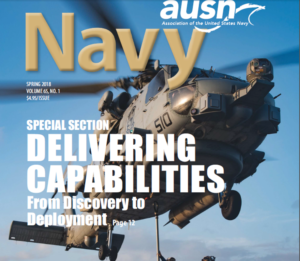US NAVY MAGAZINE: Mayflower MAGNA RIF Program (GPS Anti-Jam)
 Innovative Solutions for Warfighters
Innovative Solutions for Warfighters
By Edward Lundquist
Article can be found at http://digital.ausn.org/i/976866-spring-2018
Small companies and their innovative technologies can bring new and valuable capability to warfighters. But the little guys can be at a disadvantage when it comes to big acquisition programs. Some good ideas need a little help to prove the concept and make it available to the warfighter sooner rather than later.
The Navy offers several programs to aid small businesses and accelerate their technology, including the Small Business Innovation Research (SBIR) program and the Rapid Innovation Fund.
A small company, Mayflower Communications Co. Inc., located in Bedford, Mass., responded to an SBIR topic “compact and integrated a small anti-jam Global Positioning System (GPS) antenna.”
Six companies received Phase I SBIR contracts to propose a concept, and Mayflower was the only one to receive Phase II funding to develop their idea. Mayflower’s small antenna system (SAS) was designed to be mounted on rotary-wing aircraft to integrate with the onboard GPS receiver and protect the GPS signal from jamming.
GPS is a ubiquitous commodity with myriad uses, and not just for the military. It’s something we all takefor granted each and every day. “All of our platforms use it,” said CAPT Armen Kurdian, who served as a principal assistant program manager at Space and Naval Warfare Systems Command (SPAWAR). “We have made a huge investment in our satellite constellation.
And it’s an advantage that our adversaries will want to take away. So we need to protect this enabling capability.”
Bigger ships and aircraft are not limited by the same space, weight and power constraints — or SWaP — as smaller platforms and can carry the larger Advanced Digital Antenna Production (ADAP) seven-channel GPS anti-jam system currently in fleet-wide use. But there are platforms that need a smaller antenna system. Even the submarine community was interested. So Mayflower leveraged SAS to create the Submarine Anti-Jam GPS Enhancement (SAGE), small enough to fit on the periscope mast.
SAGE demonstrated that the SAS capability could be made smaller, and caught the eye of Bill Joo, an engineer at SPAWAR in San Diego. He thought he could leverage that technology through the Navy’s Rapid Innovation Fund to meet the needs of a variety of small vessels, aircraft (such as drones) and ground vehicles. “We found that there could be a common set of performance requirements that would be similar across large families of systems, such as small boats, ground vehicles and Military Sealift Command ships that don’t have robust systems on board, even individual Soldiers and Marines on the ground,” Kurdian said.
“Bill wanted us take SAGE and improve its performance level and, if possible, make it even smaller,” Thomas said. “So we developed two separate products — the Multi-Platform Anti-Jam GPS Navigation Antenna (MAGNA) Federated System (MAGNA-F), which consists of two separate pieces, an antenna and the antenna electronics, as well as the MAGNA Integrated System (MAGNA-I), with all of the associated GPS anti-jam electronics located on the inside of the antenna,” out of one Rapid Innovation Fund project. “MAGNA offers the counter-countermeasure that restores the advantages afforded by reliable GPS sources,” Joo said.
MAGNA works even when a satellite signal is being interrupted by the spinning rotor blades. The system detects a jamming signal and nulls out the jamming, allowing clean GPS signals to get to the receiver. “It works in much the same way as noise-cancelling headphones,” he said.
Taking the Next Step
SBIR is designed to help small companies mature their technology and develop a plan to successfully transition that technology with a viable business plan. Technology readiness levels (TRLs) are used to indicate the maturity of a technology, ranging from TRL 1, which is observing and reporting about basic principles, to TRL 9, where a system has proven itself in mission operations.
In the case of MAGNA, what started as a science and technology project became an SBIR-funded effort, with Rapid Innovation Fund funding taking the technology all the way to TRL 8, which is defined as completing and qualifying an actual system through test and demonstration, Kurdian said.
The Rapid Innovation Fund is designed to transition mature technologies into defense acquisition programs. The average Rapid Innovation Fund award is $2.1 million; 90 percent of Rapid Innovation Fund awards go to small businesses and 75 percent of those were awarded to SBIR participants.
“The Army made some additional minor adjustments to the hardware configuration to ‘connectorize’ it to their air vehicles, and they have many thousands of them — as ubiquitous as the capability they are trying to connect to,” Kurdian said. “And they are enabling other more compact products and packaging them in such a way that is useful to the warfighter, such as an individual soldier connected to a network.”
During the Rapid Innovation Fund effort, different organizations contributed to the test to achieve results that met their needs. “They wanted to integrate MAGNA to their specific platforms to make sure it worked,” Kurdian said.
Kurdian said the Navy works with small companies to help them succeed. “The Navy helps them draw that path from science and technology (S&T) to fielding. We worked with Mayflower to plan ahead for transition before the [Rapid Innovation Fund project] was awarded.”
While the SBIR programs yielded the necessary MAGNA capabilities, Joo said the Rapid Innovation Fund program provided the means to fully integrate the critical technologies, perform the core qualification tests, and produce a production representative article with high TRL.
MAGNA-F is on two platforms and flying missions today for Special Operations Command against a real threat. MAGNA-I will be integrated into the Army’s Shadow unmanned aerial vehicle program and the Navy’s Fire Scout. “As of February 2018, the MAGNA-F has over 5,200 hours of flight time in an operational environment and successfully accomplishing the mission. Recently, the MAGNA-I has been integrated and flown on a small UAS and is heading to the operational environment within the next couple of months,” said Thomas.
Kurdian is now assigned to the Navy Supply Systems Command Weapon Systems Support, where he is the director of engineering and product support. “MAGNA is probably the biggest single success story of my naval career, at least from an acquisition perspective. I’m still excited about the prospect of getting it out there.” Joo said that small companies can take a lesson from MAGNA. “Do not force a solution on the warfighter,” he said. “Address the needs of the warfighter and adapt your solution in a novel manner that you may not have foreseen.”
CAPT Edward Lundquist, USN (Ret.), writes for naval and maritime trade and professional journals.
